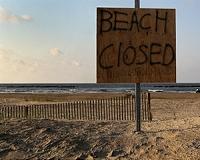 |
New Orleans, Louisiana (AFP) July 12, 2010 BP placed Monday a new cap over the ruptured oil pipe in the Gulf of Mexico, hoping to stem the catastrophic flow of toxic crude once and for all. Almost 13 weeks after America's worst environmental disaster began with a deadly explosion on the Deepwater Horizon rig, the end is finally in sight as engineers lower a device called the "Top Hat 10" from a surface ship. As of 2000 GMT, the giant valve system was 40 feet (12 meters) away from the pipe with BP officials saying it should be latched on by the end of Monday, allowing vital tests on the integrity of the well to begin. "The best-case scenario: the pressures rise to the point we anticipate they would," BP chief operating officer Doug Suttles told journalists. "We'd likely be able to keep the well shut in." If the pressure reading is too low, it would indicate a leak somewhere in the casing of the well, which extends 13,000 feet (2.5 miles, four kilometers) below the sea floor. The valves would then have to be reopened and containment operations would have to resume as crude could be forced up to the surface outside the casing of the well, spawning a whole new kind of disaster. Suttles said the integrity test could take anywhere between six and 48 hours, meaning the government and BP will likely decide whether the valves can stay shut -- and the well is sealed -- by Thursday at the latest. He added that the "Top Hat 10" has built-in abilities to pump out anti-freeze agents to stop hydrates forming under the extreme pressure and cold depths a mile down, where only robotic submarines operate in near-darkness. As the vital operations continued in the murky depths at the well site, the pain for Gulf residents was being laid bare in front of a presidential commission investigating the cause of the tragedy. Oil has washed up on beaches in all five Gulf states -- Texas, Louisiana, Mississippi, Alabama and Florida -- forcing fishing grounds to be closed and threatening scores of coastal communities with financial ruin. Despite the endgame underway in the Gulf, there was little optimism at the hearing as victims struggled to come to terms with the catastrophic damage inflicted by what could be the world's biggest ever oil spill. "Even if BP caps this well tomorrow they've done so much damage to the Gulf it's a strange consolation plan," said Darwin Bond Graham, a sociologist studying how New Orleans has recovered from Hurricane Katrina. There was anger too at Interior Secretary Ken Salazar's decision to issue a new moratorium on deepwater drilling to ensure oil companies implement safety measures following the disaster. Louisiana senator Mary Landrieu said it could lead to the loss of 120,000 jobs in the state and a "second economic disaster that has the potential to become greater than the first." On a visit to Florida, First Lady Michelle Obama urged tourists not to abandon the region. "There are still thousands of miles of beaches that have not been touched by the spill," she said. "And we need to get the word out to the rest of the country." An estimated 35,000 to 60,000 barrels of oil has been gushing out of the ruptured well since the BP-leased Deepwater Horizon sank spectacularly on April 22, two days after an explosion that killed 11 workers. In recent weeks much has been captured by a containment system and siphoned up to the surface. BP and US government officials say the capacity of the system will be tripled in the coming days so all of the oil could be contained even if the cap can't seal off the well. Suttles said despite hopes the new cap will seal the well, the British energy giant will continue drilling two relief wells to intercept and permanently plug the well. "We need to kill it down at the reservoir and cement it up so it can't ever flow again to the surface," he explained. The disaster has cost BP some 3.5 billion dollars (2.78 billion euros), although the petroleum giant's shares rose sharply on reports it was poised to sell some of its assets.
Share This Article With Planet Earth
Related Links Powering The World in the 21st Century at Energy-Daily.com
 Louisiana prays for oil to finally get capped
Louisiana prays for oil to finally get cappedBourg, Louisiana (AFP) July 11, 2010 In a modest church along the oil-ravaged Louisiana coast, Pastor Kim Voisin reaches out his hand and asks his congregation to find the strength to pull themselves through troubled times. "God is trying to free you up this morning," Voisin says to a chorus of people crying "Jesus!" at the Vision Christian Center in Bourg, Louisiana. "He hasn't promised you a rose garden," he reminds them. ... read more |
|
| The content herein, unless otherwise known to be public domain, are Copyright 1995-2010 - SpaceDaily. AFP and UPI Wire Stories are copyright Agence France-Presse and United Press International. ESA Portal Reports are copyright European Space Agency. All NASA sourced material is public domain. Additional copyrights may apply in whole or part to other bona fide parties. Advertising does not imply endorsement,agreement or approval of any opinions, statements or information provided by SpaceDaily on any Web page published or hosted by SpaceDaily. Privacy Statement |